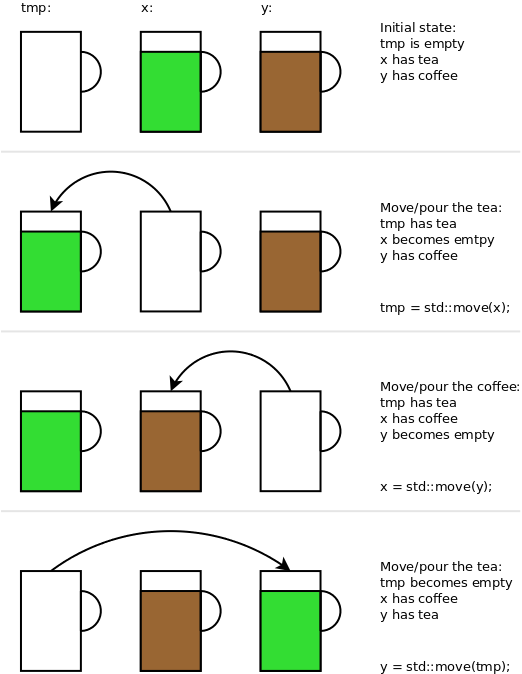Swap basics
Swapping two values
Introduction
swap is a function that swaps two values. Essentially we’re going to
implement std::swap from the standard C++ library (see the article on min
as to why).
1
2
3
4
5
6
7
8
9
10
namespace algs {
template<typename T>
// requires T is move constructible and move assignable
void swap(T & x, T & y) {
T tmp = std::move(x);
x = std::move(y);
y = std::move(tmp);
}
}
The rest of the article is about how did we get there.
Basic usage
Basic usage of swap looks like this:
1
2
3
4
5
std::vector<int> a{ 1, 2, 3 };
std::vector<int> b;
algs::swap(a, b);
std::cout << a.size() << ' ' << b.size() << '\n';
// Prints: 0 3
The idea
One intuitive explanation uses cups. Two cups are filled: one with tea, the other with coffee. Using an additional empty cup switch the contents of the first two cups.

Move or copy
In our code above, std::move actually moves only if the type has the
move constructor and move assignment defined. Otherwise it will use the copy
constructor and copy assignment.
Noexcept
Practically speaking, if the move constructor and the move assignment do not
throw, then swap is also guaranteed to not throw (i.e. it’s noexcept). Then
swap is useful to perform commit of the results at the end of a chain of
operations that might throw to indicate error.
Beware the case where swap might throw. One such case is if as explained above copy is actually used (e.g. class does not have move defined) and copying might throw.
Note that it is possible to swap objects and guarantee noexcept even if say
move constructor might throw. For example in the case of a double linked list
with allocated dummy node always present, the move constructor might
throw because it has to allocate an additional dummy node. However to swap the
value no allocation is required, hence it can be guaranteed to not throw.
Customisation points
By customisation points I mean the mechanism through which a class can define/customise its behaviour. This is a complex subject that I’m not addressing fully here.
Pre C++11, customisation for std::swap was achieved by providing
specializations/overloads for a type e.g.:
1
2
3
4
template<typename T, typename Alloc>
void swap(vector<T, Alloc> & x, vector<T, Alloc> & y) {
// swap the vector pointers here
}
That lead to the following idiomatic usage of swap for a class, so that if
there is a swap in the namespace of the arguments then ADL will select
it, otherwise swap will be looked in the std namespace.
1
2
using namespace std;
swap(x, y);
In the implementation of algs::swap above customisation is achieved by
defining move constructor and move assignment for a type.
NOTE: The customisation points can have names very similar to what we try to
customise (e.g. specializations of the function, i.e. using the same name, e.g.
swap) OR can look very different (e.g. move constructor and assignment).
Related algorithms
iter_swap(which swaps values pointed by iterators)exchange(set object to new value and return the old value of the object)